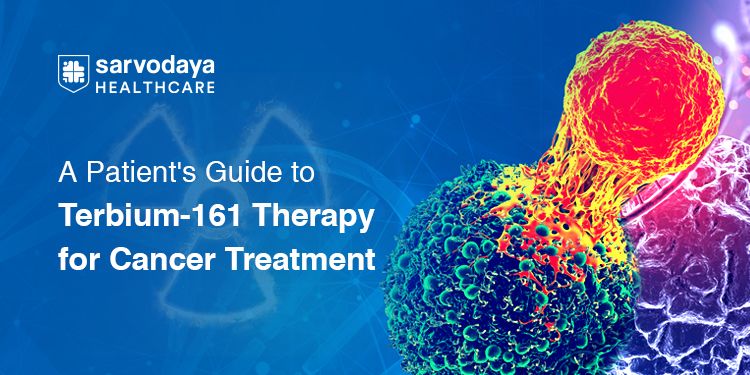Cancer treatment has improved a lot in recent years. Scientists have discovered new ways to target cancer cells while keeping healthy tissues safe. One of the newest options is Terbium-161 therapy, which uses radioactive medicine to attack cancer cells directly.
If you're wondering how this treatment works, what to expect, and if it's right for you, this guide will explain everything in simple language.
What is Terbium-161 Therapy?
Terbium-161 (Tb-161) is a special type of radioactive medicine used in targeted cancer therapy. It works by attaching itself to cancer cells and destroying them with radiation, while minimising damage to healthy tissues.
This treatment is similar to Lutetium-177 therapy, which has been used for prostate cancer and neuroendocrine tumours, but Tb-161 has additional benefits because it emits extra radiation types that can kill even the tiniest cancer cells.
How Does It Work?
- Targeting Cancer Cells: Scientists attach Terbium-161 to a molecule that finds cancer cells (like PSMA for prostate cancer or somatostatin for neuroendocrine tumors).
- Binding to Tumours: Once injected into your body, the medicine travels through the bloodstream and locks onto cancer cells .
- Radiation Release : Terbium-161 releases beta radiation, conversion electrons, and Auger electrons —these forms of radiation damage the cancer cell DNA , leading to its destruction.
- Cancer Shrinkage : Over time, the tumour shrinks or disappears, improving health and survival chances.
Which Cancers Can Be Treated with Terbium-161?
Tb-161 therapy is still being tested, but early studies show promising results for:
- Prostate Cancer (especially advanced or metastatic cases)
- Neuroendocrine Tumors (NETs) (commonly treated with Peptide Receptor Radionuclide Therapy)
- Ovarian Cancer (targeting folate receptors)
- Minimal Residual Disease (tiny cancer cells left after surgery)
This treatment may also be useful for other tumors in the future , as scientists continue to study it.
Benefits of Terbium-161 Therapy
- More Powerful Than Lutetium-177 : Tb-161 delivers stronger radiation to cancer cells.
- Targets Tiny Cancer Cells: Special electrons attack even the smallest tumors that might not be seen on scans.
- Less Damage to Healthy Tissue : It only affects cancer cells, reducing side effects compared to chemotherapy.
- Short Half-Life : The radiation fades quickly, lowering risk to other organs.
What to Expect During Treatment?
Before Therapy
- You may undergo scans (like PET or CT scans) to check if your cancer has the right markers for Tb-161 therapy.
- Doctors will explain the treatment plan, risks, and benefits.
- A blood test may be required to assess your health.
During Therapy
- The medicine is given as an injection or infusion into your vein.
- You may need to stay in the hospital for a short time.
- Radiation will start targeting cancer cells immediately .
After Therapy
- You may feel mild fatigue or have minor side effects, but most patients tolerate it well.
- Doctors will monitor your progress with follow-up scans.
- Over weeks or months, cancer cells shrink or disappear, improving your health.
Possible Side Effects
Most patients experience mild side effects compared to chemotherapy or radiation therapy. Common effects may include:
- Fatigue (temporary tiredness)
- Nausea (mild stomach discomfort)
- Dry Mouth (due to radiation near glands)
- Low Blood Cell Counts (rare but possible)
Doctors monitor patients closely and provide medications to manage any side effects.
Is Terbium-161 Therapy Right for You?
This therapy works best for patients with specific cancer types that have markers like PSMA or somatostatin receptors. Doctors will conduct tests to see if your cancer is a good match for Tb-161 therapy.
If your doctor recommends it, you can discuss:
- Expected benefits for your cancer type
- How it compares to other treatments
- Whether clinical trials are available
Future of Terbium-161 Therapy
Scientists are still testing Terbium-161 in clinical trials, but early results show great promise. It could become a leading treatment for difficult-to-treat cancers in the future.Doctors may also explore combining Tb-161 with Lutetium-177 or Actinium-225 for even more effective results.
Conclusion
Terbium-161 therapy is an exciting new approach in cancer treatment. It provides targeted radiation, destroys even tiny cancer cells, and has fewer side effects compared to traditional therapies.
At Sarvodaya Cancer Institute, Faridabad, our team of some of the best oncologists and nuclear therapy experts in Delhi NCR delivers some of the most advanced nuclear medicine therapies in India. The centre of Molecular Theranostics and Nuclear Medicine brings advanced diagnosis and new-age therapies, offering renewed hope to patients, particularly those battling with end-stage cancer or cancers that have proven resistant to conventional treatments, offering powerful results with precision and care.
If you or a loved one is considering this therapy, consult the best nuclear medicine expert at the best cancer hospital in Faridabad. With ongoing research and medical advancements, this treatment could change the future of cancer care.



















